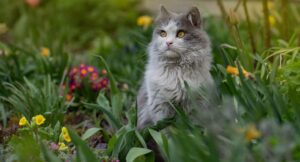Enrichment ideas for pets – build a sensory garden

Purdue University states that providing an animal with enrichment activities ‘allows the animal to have a sense of control over their environment, which can help to reduce and avoid stress’.
Sensory enrichment is all about encouraging an animal to use their senses, giving them a chance to use their brain and learn more about their environment.
This could include things like providing them with interesting new scents to make use of their extremely powerful sense of smell, adding a new vantage point to let them see new sights or introducing them to new surfaces to scratch, dig, walk on or nap on – the list goes on!
The garden is actually an excellent place to add some sensory enrichment, with plants to sniff, varied surfaces, wildlife to watch, all manner of sounds. Even just letting your dog or cat into the garden to explore on their own is a great sensory experience.
Here are a few simple tips to add extra enrichment to your pet’s day with your own sensory garden.
Can you smell that?
Adding interesting new scents is an obvious choice for a sensory garden – these could be from flowers (though be mindful, as some plants are poisonous to dogs and cats) or herbs.
A hardy plant such as rosemary or thyme would be a good choice, compared to something like basil which an overeager dog or cat could easily rip out.
Mint is another great option; it even has the added benefit of freshening their breath if they decide to have a chew!
There are many options, and it can be hard to choose between them. Ultimately, the best option is the one your dog or cat interacts with the most – since herbs are so inexpensive, perhaps try planting a few and let them self-select!
Just be sure to look into pet safe plants before digging in.
Dig your paws in!
Adding interesting new textures and surfaces is easily accomplished in a sensory garden – most gardens already have a few, such as grass, soil, and concrete. But why stop there?
A sandpit can provide a host of new activities, like digging (hopefully saving the flowerbed in the process). You could try burying some treats in the sand, just below the surface, encouraging them to use their sense of smell, too! Just be sure to cover it up when it’s not in use, to stop other animals getting in there and leaving something unpleasant behind.
On warmer days, help your dog stay cool in the sun by adding a child’s paddling pool or similar.

What’s that sound?
With neighbours, cars, birds, wind and more, a garden can be a real symphony of sound for our pets – adding something as simple as a wind chime or water fountain could take it to another level!
Safety first.
As much fun as a sensory garden can provide, there are a few safety concerns to consider too.
Animals can struggle with allergies and hay fever just like we do. The signs are very similar too. If you spot your pet sneezing, itching or suffering from runny eyes or nose more than usual then we recommend patting them down with a warm damp towel or even a bath after playing outside. This helps to remove any pollen dust from their fur and prevent them from ingesting any more.
If you’re worried about hay fever in your pet, or if they’re showing more severe symptoms, be sure to contact your vet.
In addition, some flowers, herbs, and plants can be problematic to pets, and some are downright dangerous. Any reputable garden centre should be able to point you in the right direction of pet-friendly plants, or a simple search online will tell you all you need to know.
Have fun with your sensory garden!
The only limit to creating an amazing sensory experience for your pet is your imagination!
Old tyres, upturned planter pots, wooden pallets or whatever else you have lying around the house can quite easily be transformed into something your pet will find fascinating. The possibilities are endless!